
Draw the structure corresponding to each IUPAC name.
a.
b.
c.
d. cyclobutylcycloheptane
e.
f.
g
h.
i.
j.
(a)
Interpretation: The structure corresponding to
Concept introduction: The systematic naming of organic compound is given by IUPAC nomenclature. The naming of organic compound is done such that the structure of organic compound is correctly interpreted from the name.
Rules for writing structural formula from IUPAC are:
1. First identify the word root for the given compound.
2. The suffix used in the compound like –ene.
3. Identify the position, location, and number of the substituent bonded to the carbon chain.
Answer to Problem 4.40P
The structure corresponding to
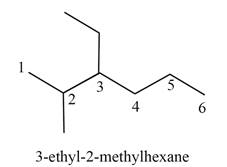
Explanation of Solution
The given IUPAC name is
Rules for writing structural formula from IUPAC are
1. First identify the word root for the given compound.
2. The suffix used in the compound like –ene.
3. Identify the position, location, and number of the substituent bonded to the carbon chain.
The given name is
Thus, the correct structure of
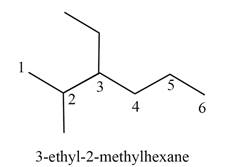
Figure 1
The structure corresponding to the given name is shown in Figure 1.
(b)
Interpretation: The structure corresponding to
Concept introduction: The systematic naming of organic compound is given by IUPAC nomenclature. The naming of organic compound is done such that the structure of organic compound is correctly interpreted from the name.
Rules for writing structural formula from IUPAC are:
4. First identify the word root for the given compound.
5. The suffix used in the compound like –ene.
6. Identify the position, location, and number of the substituent bonded to the carbon chain.
Answer to Problem 4.40P
The structure corresponding to
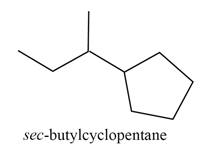
Explanation of Solution
The given IUPAC name is
The given name is

Figure 2
The structure corresponding to the given name is shown in Figure 2.
(c)
Interpretation: The structure corresponding to
Concept introduction: The systematic naming of organic compound is given by IUPAC nomenclature. The naming of organic compound is done such that the structure of organic compound is correctly interpreted from the name.
Rules for writing structural formula from IUPAC are:
1. First identify the word root for the given compound.
2. The suffix used in the compound like –ene.
3. Identify the position, location, and number of the substituent bonded to the carbon chain.
Answer to Problem 4.40P
The structure corresponding to
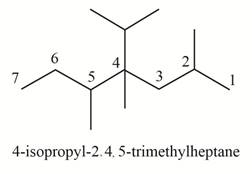
Explanation of Solution
The given IUPAC name is
The given name is
Thus, the correct structure of

Figure 3
The structure corresponding to the given name is shown in Figure 3.
(d)
Interpretation: The structure corresponding to cyclobutylcycloheptane is to be drawn.
Concept introduction: The systematic naming of organic compound is given by IUPAC. The naming of organic compound is done such that the structure of organic compound is correctly interpreted from the name.
Answer to Problem 4.40P
The structure corresponding to cyclobutylcycloheptane is shown as,
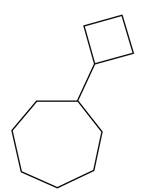
Explanation of Solution
The given IUPAC name is cyclobutylcycloheptane. The given name is cyclobutylcycloheptane. The word root used in this is hept. It means structure contains seven carbon atoms. The hydrocarbons that are attached to the longest chain are called substituents and they are written as prefix in alphabetical order. Therefore, the name suggests that one cyclobutyl substituents is attached to the carbon atom of cycloheptane.
Thus, the correct structure of cyclobutylcycloheptane is shown below.

Figure 4
The structure corresponding to the given name is shown in Figure 4.
(e)
Interpretation: The structure corresponding to
Concept introduction: The systematic naming of organic compound is given by IUPAC. The naming of organic compound is done such that the structure of organic compound is correctly interpreted from the name.
Answer to Problem 4.40P
The structure corresponding to

Explanation of Solution
The given IUPAC name is
Thus, the correct structure of

Figure 5
The structure corresponding to the given name is shown in Figure 5.
(f)
Interpretation: The structure corresponding to
Concept introduction: The systematic naming of organic compound is given by IUPAC. The naming of organic compound is done such that the structure of organic compound is correctly interpreted from the name.
Answer to Problem 4.40P
The structure corresponding to
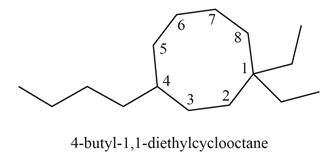
Explanation of Solution
The given IUPAC name is
Thus, the correct structure of

Figure 6
The structure corresponding to the given name is shown in Figure 6.
(g)
Interpretation: The structure corresponding to
Concept introduction: The systematic naming of organic compound is given by IUPAC. The naming of organic compound is done such that the structure of organic compound is correctly interpreted from the name.
Answer to Problem 4.40P
The structure corresponding to

Explanation of Solution
The given IUPAC name is
Thus, the correct structure of

Figure 7
The structure corresponding to the given name is shown in Figure 7.
(h)
Interpretation: The structure corresponding to
Concept introduction: The systematic naming of organic compound is given by IUPAC. The naming of organic compound is done such that the structure of organic compound is correctly interpreted from the name.
Answer to Problem 4.40P
The structure corresponding to
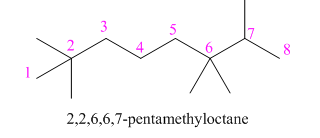
Explanation of Solution
The given IUPAC name is
Thus, the correct structure of

Figure 8
The structure corresponding to the given name is shown in Figure 8.
(i)
Interpretation: The structure corresponding to
Concept introduction: The systematic naming of organic compound is given by IUPAC. The naming of organic compound is done such that the structure of organic compound is correctly interpreted from the name.
Rules for writing structural formula from IUPAC are:
4. First identify the word root for the given compound.
5. The suffix used in the compound like –ene.
6. Identify the position, location, and number of the substituent bonded to the carbon chain.
Answer to Problem 4.40P
The structure corresponding to
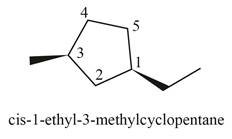
Explanation of Solution
The given IUPAC name is
Rules for writing structural formula from IUPAC are
7. First identify the word root for the given compound.
8. The suffix used in the compound like –ene.
9. Identify the position, location, and number of the substituent bonded to the carbon chain.
The given name is
Thus, the correct structure of
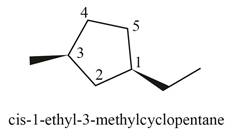
Figure 9
The structure corresponding to the given name is shown in Figure 9.
(j)
Interpretation: The structure corresponding to
Concept introduction: The systematic naming of organic compound is given by IUPAC. The naming of organic compound is done such that the structure of organic compound is correctly interpreted from the name.
Rules for writing structural formula from IUPAC are:
10. First identify the word root for the given compound.
11. The suffix used in the compound like –ene.
12. Identify the position, location, and number of the substituent bonded to the carbon chain.
Answer to Problem 4.40P
The structure corresponding to
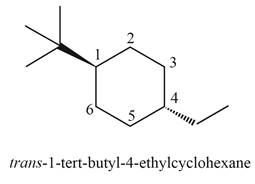
Explanation of Solution
The given IUPAC name is
Rules for writing structural formula from IUPAC are
13. First identify the word root for the given compound.
14. The suffix used in the compound like –ene.
15. Identify the position, location, and number of the substituent bonded to the carbon chain.
The given name is
Thus, the correct structure of

Figure 10
The structure corresponding to the given name is shown in Figure 10.
Want to see more full solutions like this?
Chapter 4 Solutions
Organic Chemistry
Additional Science Textbook Solutions
Thermodynamics, Statistical Thermodynamics, & Kinetics
Fundamentals of Heat and Mass Transfer
Chemistry: Structure and Properties (2nd Edition)
Chemistry: Atoms First
Chemistry
The Organic Chem Lab Survival Manual: A Student's Guide to Techniques
- Draw the structure corresponding to each IUPAC name. a.3-ethyl-2-methylhexane b. sec-butylcyclopentane c.4-isopropyl-2,4,5-trimethylundecane d.cyclobutylcycloheptane e.3-ethyl-1,1-dimethylcyclohexane f. 4-butyl-1,1-diethylcyclooctane g.6-isopropyl-2,3-dimethyldodecane h. 2,2,6,6,7-pentamethyloctane i. cis-1-ethyl-3-methylcyclopentane j. trans-1-tert-butyl-4-ethylcyclohexanearrow_forward(a) 1-chloropropane (b) 2-chloropropane(c) 2,2-dimethylbutane (d) 2,3-dimethylbutane(e) 1-bromo-4-methylbenzene (f) 1-bromo-2-methylbenzene,arrow_forwardDraw a structure for each compound (includes old and new names).(a) 3-methylpent-1-ene (b) cis-3-methyl-3-hexene (c) 3,4-dibromobut-1-ene(d) 1,3-cyclohexadienearrow_forward
- a. What is the chemical structure of biphenyl, circle functional groupsdifferent than alkane, alkene, alkyne? b. Is it polar or nonpolar? _______________________ c. What is its water solubility in g/L? __________________________arrow_forwardHow do structures of these IUPAC names look like? a) 2-Methylhexan-2-olb) 4-Mercaptocyclohex-2-enolc) Ethyl methyl sulphided) 4-Mercapto-3-methylthiopentene e) 2-Propoxy-1-(2-propoxyethoxy)propanearrow_forward(a) which a disubstituted cis- alkene? (b) which is the geometric isomer of D? (c) which is a tri-substituted Z- alkene? (d) which is the most stable alkene? (e) which has the highest boiling point? (f) which has the highest MP?arrow_forward
- Given each of the IUPAC names provided, draw the corresponding structure.(a) 2,4-dicyclopropyl-2-ethoxyhexane(b) 1,2-dichloro-1-(2-methylpropyl)-4-nitrocyclohexane(c) 1,3-dicyclopentyl-1,2,3,4-tetramethoxycyclooctane(d) 1-cyclobutyl-4-(1,1-dimethylethyl)-2,4-dinitrononane(e) 1-(1,1-dimethylbutyl)-2-ethoxy-1,2,3-trinitrocyclobutane(f) 1,2,4-tricyclopropyl-1-(2,2-dichloropentyl)cyclohexane(g) 4-(2-chloro-1-methoxyethyl)-1,1-dinitroheptane(h) 3,3,4-trichloro-1-cyclohexoxy-4-(1,1-dichloroethyl)decanearrow_forward3. a. What is the chemical structure of benzoic acid, circle functional groups different than alkane,alkene, alkyne? b. Is it polar or nonpolar? _______________________ c. What is its water solubility in g/L? __________________________arrow_forwardEach iupac is wrong, what are the correct iupac? -2-pentylbut-2-ene -2,3,4,5-tetraethylhexane -1-chloro-2-bromo-3-iodo-4-fluorohex—6-enearrow_forward
- a) Write the name b) draw the structure product formed from the reaction of 3-methylpent-2-ene 1) H2O in the presence of H2SO4 2)ethanol in the presence of H2SO4arrow_forwardDraw the structure corresponding to each IUPAC name: (a) 5,5-dimethyl-3-heptyne; (b) 1,3-dimethylcyclohexene.arrow_forwardDraw the structure corresponding to each IUPAC name. a. 2,3,4,5−tetramethyldecane draw structure ... b. cyclononane draw structure ...arrow_forward
 Organic Chemistry: A Guided InquiryChemistryISBN:9780618974122Author:Andrei StraumanisPublisher:Cengage Learning
Organic Chemistry: A Guided InquiryChemistryISBN:9780618974122Author:Andrei StraumanisPublisher:Cengage Learning
